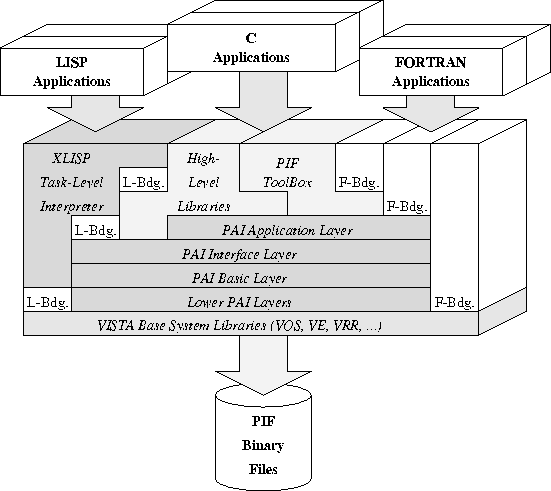
Figure: VISTA data level structure (L-Bdg. ... LISP-Binding, F-Bdg. ... FORTRAN-Binding)





Figure: VISTA data
level structure (L-Bdg. ... LISP-Binding, F-Bdg. ... FORTRAN-Binding)
The VISTA data level approach combines both the interchange file approach and the client-server approach by using PIF in a textual and a binary representation as a persistent framework interchange format, and a layered PIF Application Interface (PAI) with its corresponding high-level libraries as a procedural interface to the data level services.
Fig. 3.4 tries to illustrate the VISTA data level structure. The VISTA Base System Libraries on the very bottom provide system-near services and separate operating system dependencies not only from the data level but from the whole framework. Both LISP and FORTRAN language bindings are generated using the TAC [Hala94]. On top of the base system libraries are the various layers of the PIF Application Interface, which provide a low-level procedural interface for TCAD applications, map the application's data structures onto the PIF Binary File (PBF) structures, and provide maintenance, inquiry, access and retrieval services to the applications. It should be noted that all C applications have unrestricted access to those internal PAI layers, although it is usually dangerous and does not make much sense to use those internal layers in application programs.
The uppermost PAI Application Layer provides an array-oriented view of PBF data well suited for FORTRAN applications. But also the more complex high-level libraries and the PIF tool box do use this PAI layer. The various high level libraries provide different views of the PBF data, employ their own internal data structures and give the application programmer the ability to choose from the variety of libraries the ones which are best fit to the application data structures and provide the functionality the application needs. The PIF tool box does not use its own internal data structures, it uses the PAL and the high-level libraries rather to provide a number of small and comfortable tools available as a library for application programs.
Various LISP interfaces exist to the XLISP task level interpreter which serves as the basis for LISP-based applications and task level programs. The FORTRAN interfaces on the other hand allow the large number of existing FORTRAN TCAD applications to be integrated with minimum effort into the data level.
As discussed in [Hala94], a bottom-up approach has been gone on the data-level implementation as well as in the whole VISTA framework. This approach effectively avoids a confinement to a specific architecture that would result in an inflexible data level and thus lead to a framework that cannot be adapted to the environmental needs of a simulation site.



